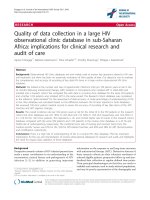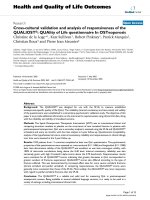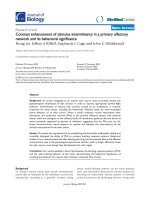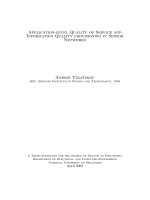Packet level quality of service analysis of multiclass services in a WCDMA mobile network
Bạn đang xem bản rút gọn của tài liệu. Xem và tải ngay bản đầy đủ của tài liệu tại đây (1.06 MB, 170 trang )
Packet Level Quality of Service Analysis of Multiclass Services
in a WCDMA Mobile Network
Nie Chun
(B. Eng., Northwestern Polytechnic University, P.R. China)
A THESIS SUBMITTED
FOR THE DEGREE OF MASTER OF ENGINEERING
DEPARTMENT OF ELECTRICAL AND COMPUTER ENGINEERING
NATIONAL UNIVERSITY OF SINGAPORE
2003
Acknowledgements______________________________________________________i
Acknowledgements
With this opportunity I would like to express my sincere appreciation to all people
who have helped me to finish this thesis.
First of all, I would like to express my great gratitude to my supervisors, Dr. CHEW
Yong Huat and Dr. WONG Tung Chong. They provided me with this research project
and kindly guided me with my work for two and half years. Dr. CHEW and Dr. WONG
have provided a lot of valuable advices and ideas which open my mind and help me to
overcome all difficulties along the way for my research work. It would be impossible for
me to complete this thesis without their long-term assistance and guidance.
Furthermore, it gives me pleasure to thank Xiao Lei and Yao Jianxin, who are my
partners in our research group. I often discussed problems that I encountered in my work
with them and gained many benefits from their suggestions.
Next, I am also grateful to Yang Yang, who is my lab-mate. He helped me with some
programming issues and techniques with Mathematica and Matlab softwares.
Besides, many thanks for Wang Xiaofeng, one of my good friends in NUS. He gave
me much help when I first came to Singapore and helped me adapt to the new
environment quickly.
Finally, I specially give my hearty gratitude to my families, including my parents and
my elder brother. They encouraged me to pursue this Master of Engineering degree in
NUS and supported me throughout the past few years. Their selfless help and kind
concern play a critical role in my studies and work.
ii
Contents
Acknowledgements ............................................................................................................ i
Contents ............................................................................................................................. ii
Summary........................................................................................................................... vi
List of Tables .................................................................................................................. viii
List of Figures................................................................................................................... ix
List of Illustrations......................................................................................................... xiii
List of Symbols .............................................................................................................. xvii
Chapter 1. Introduction.................................................................................................... 1
1.1 Basic QoS Issues....................................................................................................... 3
1.2 Previous Works......................................................................................................... 4
1.3 Aims of Thesis .......................................................................................................... 6
1.4 Thesis Organization .................................................................................................. 7
Chapter 2. UMTS Networks and QoS Architecture.................................................... 10
2.1 UMTS Framework .................................................................................................. 10
2.2 Wideband CDMA Air Interface.............................................................................. 13
2.2.1 WCDMA Basic Concept.................................................................................. 14
2.2.2 Spreading and Scrambling ............................................................................... 14
2.2.3 Modulation and Channel Coding ..................................................................... 16
2.2.4 Radio Resource Management .......................................................................... 16
iii
2.3 UMTS QoS Class.................................................................................................... 17
2.3.1 Basic Classes.................................................................................................... 19
2.3.2 QoS Attributes ................................................................................................. 21
2.4 Traffic Models ........................................................................................................ 21
2.4.1 Voice Model..................................................................................................... 22
2.4.2 Video Model .................................................................................................... 23
2.4.3 Web-Browsing Model...................................................................................... 25
2.4.4 Data Model....................................................................................................... 27
2.5 Conclusion .............................................................................................................. 29
Chapter 3. Analysis of Go-Back-N ARQ .......................................................................30
3.1 Go-Back-N ARQ Introduction.................................................................................32
3.2 Analysis of the Lengthened Activity Factor ............................................................38
3.3 Analysis of Packet Loss Rate...................................................................................49
3.4 Analysis of Delay.....................................................................................................50
3.5 Discussions ..............................................................................................................53
3.6 Conclusion ...............................................................................................................54
Chapter 4 Analysis of Outage Probability.................................................................... 56
4.1. System Model ........................................................................................................ 58
4.1.1 Single-Connection System Model ................................................................... 59
4.1.2 Multi-Connection System Model..................................................................... 62
4.2 MAC/RLC Method ................................................................................................. 65
4.3 Power Distribution Algorithm ................................................................................ 67
4.3.1 Power Distribution for Single-Connection System Model .............................. 67
iv
4.3.2 Power Distribution for Multi-Connection System Model ............................... 71
4.4 Outage Probability .................................................................................................. 75
4.4.1 Outage Probability for Single-Connection System Model .............................. 76
4.4.2 Outage Probability for Multi-Connection System Models .............................. 78
4.5 Lengthened Activity Factor .................................................................................... 80
4.5.1 Lengthened Activity Factor in Single-Connection System Model .................. 82
4.5.2 Lengthened Activity Factor in Multi-Connection System Model ................... 83
4.5.3 Iteration Method............................................................................................... 84
4.6 Conclusion .............................................................................................................. 86
Chapter 5 Analysis of Packet Level QoS ...................................................................... 87
5.1 Packet Loss Rate Performance................................................................................ 87
5.1.1 Packet Loss Rate in the Single-Connection System Model............................. 88
5.1.2 Packet Loss Rate in the Multi-Connection System Model .............................. 90
5.2 Delay Performance.................................................................................................. 92
5.2.1 Delay Performance in Single-Connection System Model ............................... 93
5.2.2 Delay Performance in Multi-Connection System Model................................. 95
5.3. Conclusion ............................................................................................................. 97
Chapter 6. Numerical Results.........................................................................................98
6.1 Simulation Model Specifications.............................................................................99
6.2 Statistical Characteristics of Pareto on/ParetoExponential off Process.................103
6.3 Numerical Results in the Single-Connection System Model.................................106
6.3.1 Quality of Service for Voice Services ............................................................107
6.3.2 Quality of Service for Video Services ............................................................108
v
6.3.3 Quality of Service for Web-browsing Services ..............................................109
6.3.4 Quality of Service for Data Services ..............................................................112
6.4 Numerical Results in the Multi-Connection System Model ..................................114
6.4.1 Quality of Service Performances in Group One .............................................115
6.4.2 Quality of Service Performances in Group Two.............................................116
6.4.3 Quality of Service Performances in Group Three...........................................116
6.4.4 Quality of Service Performances in Group Four ............................................118
6.5. Discussion of Numerical Results ..........................................................................123
6.6. QoS-Based Call Admission Control and Admission Regions..............................125
6.6.1 Admission Region for the Single-Connection System Model........................127
6.6.2 Admission Region for the Multi-Connection System Model .........................128
6.7 Conclusions............................................................................................................130
Chapter 7. Conclusion and Future Works ................................................................. 131
7.1 Conclusion ............................................................................................................ 131
7.2 Future Work .......................................................................................................... 133
Bibliography .................................................................................................................. 134
Appendix Intercell Interference Analysis................................................................... 142
Summary_______________________________________________________________
vi
Summary
In the future Universal Mobile Telecommunications System (UMTS) network,
Quality of Service (QoS) provisioning is a critical issue. In contrast to earlier generations
of telecommunication systems, the UMTS network can enable a variety of services with
different QoS requirements within each mobile user simultaneously. Wideband CDMA
(WCDMA) is chosen as the multiple access technology and the air interface of UMTS.
This thesis studies the QoS performances in the WCDMA system. Due to the unique
characteristics of the UMTS network, a complete and detailed QoS architecture is
proposed to deal with all related topics on QoS provisioning. All services in the UMTS
network are classified into four classes in the proposed QoS architecture. The services
consist of the conversational class, streaming class, interactive class and background
class. These four classes are different in terms of their QoS requirements. Although QoS
provisioning issues have long attracted a lot of research interests and many discussions
have been made in this area, no analytical work has been done to solve the QoS
provisioning problems for all the four UMTS classes. The objective of this thesis is to
address the packet level QoS issues at the network layer of the WCDMA system with
deterministic mathematical methods. Besides, it is also our aim to give a QoS-based call
admission control (CAC) algorithm at the packet level of the network layer and to obtain
the corresponding feasible admission regions (ARs). In this thesis, we study the wireless
channel between mobile users and base stations and focus our work on the uplink of the
WCDMA system.
Summary_______________________________________________________________
vii
Firstly, this thesis introduces the rudimentary UMTS network and its QoS
architecture. We develop two system models for analysis based on them. The two system
models are called single-connection system model and multi-connection system model,
respectively. Only a single service is permitted within each mobile user in the singleconnection system model, while multi-connection multiclass services are permitted
within each mobile user in the multi-connection system model. Assuming perfect power
control, efficient power distribution algorithms are developed in the two system models.
The Go-Back-N (GBN) automatic retransmission request (ARQ) mechanism is used for
the services of the interactive and background classes. The effects of the GBN ARQ in
the WCDMA channel are examined in details. The outage probability of each class is
formulated for each service in the single-connection and multi-connection system models,
taking into consideration of the effects of the GBN ARQ.
Secondly, we present the packet level QoS performances, including packet loss rate
and average delay, for all services in the WCDMA system. The packet level QoS
performances are directly associated with the data link layer QoS attributes, such as
outage probability. Accurate mathematical formulas are developed for the outage
probabilities, the packet loss rates and the average delays of each service in the two
system models.
Lastly, a QoS-based CAC algorithm is given, satisfying the packet level QoS
requirements of all admitted services. Furthermore, we derive the ARs for the two system
models based on this CAC scheme and appropriate system parameters. The ARs can
assure that any admitted service in the WCDMA system is able to achieve its required
QoS levels.
List of Tables___________________________________________________________
viii
List of Tables
Table 3.1 Packet Beginning Transmission Time and Transmission Time in the WCDMA
Channel ..............................................................................................................................42
Table 6.1 QoS Attributes .................................................................................................100
Table 6.2 System Parameters...........................................................................................101
Table 6.3 Traffic Parameters............................................................................................102
Table 6.4 Traffic Parameters in Binomial Assumption ...................................................103
Table 6.5 Number of Services in the Single-Connection System Model ........................106
Table 6.6 Number of Mobile Users and Services in the Multi-Connection System Model ..
..........................................................................................................................................115
List of Figures___________________________________________________________
ix
List of Figures
Figure 2.1 UMTS Architecture ......................................................................................... 11
Figure 2.2 Spreading and Scrambling............................................................................... 15
Figure 2.3 Architecture of a Bearer Service ..................................................................... 18
Figure 2.4 Traffic Model of a Voice Service.................................................................... 22
Figure 2.5 Traffic Model of Video Services..................................................................... 23
Figure 2.6 Low-bit-rate on/off Minisource of a Video Service ........................................ 24
Figure 2.7 High-bit-rate on/off Minisource of a Video Service ....................................... 25
Figure 2.8 Traffic Model of Web-browsing Services....................................................... 26
Figure 2.9 Traffic Model of Data Services ....................................................................... 27
Figure 3.1 Go-Back-N ARQ Illustrations......................................................................... 34
Figure 3.2 Lengthening of on Period in WCDMA Channel............................................. 35
Figure 3.3 Probability Density Function of Pareto Distribution (a=0.5, c=1.1)............... 37
Figure 3.4 Cumulative Distribution Function of Pareto Distribution (a=0.5, c=1.1) ....... 38
Figure 3.5 Packet Transmission Operations in the Go-Back-N ARQ system .................. 40
Figure 3.6 Packet Removal Operations in the Go-Back-N ARQ System......................... 45
Figure 3.7 Packet Delay Illustration in the WCDMA Channel ........................................ 51
Figure 4.1 Spreading and Scrambling for the Single-Connection System Model............ 60
Figure 4.2 Spreading and Scrambling for the Multi-Connection System Model ............. 63
Figure 6.1 Cellular Mobile Network Model ......................................................................99
List of Figures___________________________________________________________x
Figure 6.2 Probability Distribution for the Number of Active Spreading Codes Used by
Web-browsing Services ...................................................................................................105
Figure 6.3 Probability Distribution of the Number of Active Spreading Codes Used by
Data Services ...................................................................................................................105
Figure 6.4 Packet Loss Rate/Outage Probability of Voice Services (in the SingleConnection System Model)..............................................................................................107
Figure 6.5 Packet Loss Rate / Outage Probability of Video Services (in the SingleConnection System Model)..............................................................................................108
Figure 6.6 Lengthened Activity Factor of Web-browsing Services (in the SingleConnection System Model)..............................................................................................109
Figure 6.7 Outage Probability of Web-browsing Services (in the Single-Connection
System Model) .................................................................................................................109
Figure 6.8 Packet Loss Rate of Web-browsing Services (in the Single-Connection System
Model)..............................................................................................................................110
Figure 6.9 Average Delay of Web-browsing Services (in the Single-Connection System
Model)..............................................................................................................................110
Figure 6.10 Average Number of Web-browsing Packets in the Buffer (in the SingleConnection System Model)..............................................................................................111
Figure 6.11 Lengthened Activity Factor of Data Services (in the Single-Connection
System Model) .................................................................................................................112
Figure 6.12 Outage Probability of Data Services (in the Single-Connection System
Model)..............................................................................................................................112
Figure 6.13 Packet Loss Rate of Data Services (in the Single-Connection System Model)
List of Figures___________________________________________________________
xi
..........................................................................................................................................113
Figure 6.14 Average Delay of Data Services (in Single-Connection System Model).....113
Figure 6.15 Average Number of Data packets in the Buffer (in the Single-Connection
System Model) .................................................................................................................114
Figure 6.16 Packet Loss Rate/Outage Probability of Voice Services (Group 1, in the
Multi-Connection System Model) ...................................................................................115
Figure 6.17 Packet Loss Rate/Outage Probability of Video Services (Group 2, in the
Multi-Connection System Model) ...................................................................................116
Figure 6.18 Packet Loss Rate/Outage Probability of Voice Services (Group 3, in the
Multi-Connection System Model) ...................................................................................117
Figure 6.19 Packet Loss Rate/Outage Probability of Video Services (Group 3, in the
Multi-Connection System Model) ...................................................................................117
Figure 6.20 Lengthened Activity Factor of Web-browsing Services (Group 4, in the
Multi-Connection System Model) ...................................................................................118
Figure 6.21 Outage Probability of Web-browsing Services (Group 4, in the MultiConnection System Model)..............................................................................................119
Figure 6.22 Packet Loss Rate of Web-browsing Services (Group 4, in the MultiConnection System Model)..............................................................................................119
Figure 6.23 Average Delay of Web-browsing Services (Group 4, in the Multi-Connection
System Model) .................................................................................................................120
Figure 6.24 Average Number of Web-browsing Packets in the Buffer (Group 4, MultiConnection System Model)..............................................................................................120
List of Figures___________________________________________________________
xii
Figure 6.25 Lengthened Activity Factor of Data Services (Group 4, in the MultiConnection System Model)..............................................................................................121
Figure 6.26 Outage Probability of Data Services (Group 4, Multi-Connection System
Model)..............................................................................................................................121
Figure 6.27 Packet Loss Rate of Data Services (Group 4, in the Multi-Connection System
Model)..............................................................................................................................122
Figure 6.28 Average Delay of Data Services (Group 4, in the Multi-Connection System
Model)..............................................................................................................................122
Figure 6.29 Average Number of Data Packets in the Buffer (Group 4, in the MultiConnection System Model)..............................................................................................123
Figure 6.30 Call Admission Control Procedures .............................................................126
Figure 6.31 Admission Region of Single-Connection System Model (Number of Video
Services = 0) ....................................................................................................................128
Figure 6.32 Admission Region for Multi-Connection System Model (Number of Mobile
Users in Group 2 = 0) ......................................................................................................129
List of Illustrations_______________________________________________________
xiii
List of Illustrations
3G
Third Generation
3GPP
Third Generation Partnership Project
ACK
Acknowledgement
AMPS
Advanced Mobile Phone System
AR
Admission Region
ARQ
Automatic Repeat Request
ASK
Amplitude Shift Keying
BE
Best Effort
BER
Bit Error Rate
BPSK
Binary Phase Shifting Keying
BS
Base Station
CAC
Call Admission Control
CBR
Constant Bit Rate
CDMA
Code Division Multiple Access
CDF
Cumulative Distribution Function
CN
Core Network
CS
Circuit Switching
DCH
Dedicated Channel
List of Illustrations_______________________________________________________
xiv
DS-CDMA
Direct Sequence CDMA
ETSI
European Telecommunications Standards Institute
FCFS
First Come First Serve
FDD
Frequency Division Duplex
FDMA
Frequency Division Multiple Access
FEC
Forward Error Correction
FSK
Frequency Shift Keying
FTP
File Transfer Protocol
GSM
Global System for Mobile Communications
GGSN
Gateway GPRS Support Node
GMSC
Gateway MSC
GPRS
General Packet Radio System
HLR
Home Location Register
IEEE
Institute of Electrical and Electronic Engineers
International Mobile Telephony, 3rd Generation
IMT-2000
Networks
ITU
International Telecommunication Union
IP
Internet Protocol
IS-95
Interim Standard 95
ITU
International Telecommunication Union
LC
Load Control
MAC
Medium Access Control
MAI
Multiple Access Interference
List of Illustrations_______________________________________________________
xv
ME
Mobile Equipment
MS
Mobile Station
MSC
Mobile Services Switching Center
NACK
Negative Acknowledgement
Node B
UMTS Base Station
PC
Power Control
PDC
Personal Digital Cellular
Probability Density Function
PLMN
Public Land Mobile Network
PN
Pseudo Noise
PS
Packet Switching
PSK
Phase Shift Keying
OVSF
Orthogonal Variable Spreading Factor
QoS
Quality of Service
QPSK
Quadrature Phase Shift Keying
RAB
Radio Access Bearer
RAN
Radio Access Network
RNC
Radio Network Controller
RRM
Radio Resource Management
SIM
Subscriber Identity Module
SINR
Signal to Interference Plus Noise Ratio
SGSN
Serving GPRS Support Node
SMS
Short Message Service
List of Illustrations_______________________________________________________
xvi
SS
Spreading Spectrum
TDD
Time Division Duplex
TE
Terminal Equipment
TS
Technical Specification
UE
User Equipment
UL
Uplink
UMTS
Universal Mobile Telecommunication Service
USIM
UMTS Subscriber Identity Module
UTRA
Universal Terrestrial Radio Access
UTRAN
UMTS Terrestrial Radio Access Network
VBR
Variable Bit Rate
VLR
Visitor Location Register
WCDMA
Wideband Code Division Multiple Access
Web-browsing
World Wide Web Browsing
List of Symbols __________________________________________________________
xvii
List of Symbols
Location parameters for the Pareto off period of a non-real-time
aoff
service.
Location parameters for the Pareto on period of a non-real-time
aon
service.
ak ,off , k ∈ {3, 4}
Location parameter for the Pareto off period of a web-browsing and
data service, respectively.
ak ,on , k ∈ {3, 4}
Location parameter for the Pareto off period of a web-browsing and
data service, respectively.
A
Area of a square cell.
α
Transition rate from the off state to the on state of a low-bit-rate
video minisource.
α k , k ∈ {1,3, 4}
Transition rates from the off state to the on state of voice, webbrowsing and data, respectively.
Buffer size of a non-real-time service.
B
Bk , k ∈ {3, 4}
*
BERk ,
k ∈ {1, 2l , 2h,3, 4}
β
Buffer sizes for of web-browsing and data, respectively.
BER requirements of voice, video (low-bit-rate), video (high-bitrate), web-browsing and data, respectively.
Transition rate from the on state to the off state of a low-bit-rate
List of Symbols __________________________________________________________
xviii
video minisource.
β k , k ∈ {1,3, 4}
Transition rates from the on state to the off state of voice, webbrowsing and data, respectively.
coff
Shape parameters for the Pareto off period of a non-real-time
service.
con
Shape parameters for the Pareto on period of a non-real-time
service.
ck ,off , k ∈ {3, 4}
Shape parameter for the Pareto off period of a web-browsing and
data service, respectively.
ck ,on , k ∈ {3, 4}
Shape parameter for the Pareto on period of a web-browsing and
data service, respectively.
Di ,k ,
Delays of voice, video (low-bit-rate), video (high-bit-rate), web-
k ∈ {1, 2l , 2h,3, 4}
browsing and data, respectively within ith mobile user in the multiconnection system model.
Dk ,
Delays of voice, video (low-bit-rate), video (high-bit-rate), web-
k ∈ {1, 2l , 2h,3, 4}
browsing and data, respectively in the single-connection system
model.
*
Dk ,
k ∈ {1, 2l , 2h,3, 4}
εm , εd
Delay requirements of voice, video (low-bit-rate), video (high-bitrate), web-browsing and data, respectively.
Two independent Guassian random variables with zero mean and
σ 2 variance.
η
Average power of AWGN.
Gk ,
Spreading gains of voice, video (low-bit-rate), video (high-bit-rate),
List of Symbols __________________________________________________________
xix
web-browsing and data, respectively.
γ k* ,
k ∈ {1, 2l , 2h,3, 4}
Ii ,
k ∈ {1, 2l , 2h,3, 4}
SINR requirements of voice, video (low-bit-rate), video (high-bitrate), web-browsing and data, respectively.
Intercell interference of a voice, video (low-bit-rate), video (highbit-rate), web-browsing and data service.
Ii, j ,
Intercell interference of a voice, video (low-bit-rate), video (high-
k ∈ {1, 2l , 2h,3, 4}
bit-rate), web-browsing and data service within the ith mobile user.
I int ercell
k
Intercell interference.
Number of packets that are transmitted in the channel conditioned
on that there are l packets in a Pareto on period.
l
Number of packets in a Pareto on period.
li ,k ,
The instantaneous number of active spreading codes used by all
k ∈ {1,2l,2h,3,4}
voice, video (low-bit-rate), video (high-bit-rate), web-browsing and
data services within the ith mobile user, respectively in the multiconnection system model.
lk ,
The instantaneous number of active spreading codes used by all
k ∈ {1, 2l , 2h,3, 4}
voice, video (low-bit-rate), video (high-bit-rate), web-browsing and
data services, respectively in the single-connection system model.
Lk ,
k ∈ {1,2,3,4}
λ
Number of bits in voice, video, web-browsing and data packets,
respectively.
Transition rate from the off state to the on state of a high-bit-rate
video minisource.
List of Symbols __________________________________________________________
xx
mi
Number of retransmissions for the ith packet conditioned on that
there are l packets in an on period.
M
Number of low-bit-rate spreading codes used by a video service
M re
Maximum number of retransmissions.
M rek , k ∈ {3, 4}
Maximum number of retransmissions for web-browsing and data,
respectively.
Transition rate from the on state to the off state of a high-bit-rate
µ
ni ,k ,
k ∈ {1,2,3,4}
ntr
video minisource.
Number of voice, video, web-browsing and data services within the
ith mobile user in a cell in the multi-connection system model.
Number of transmissions that occur before the last packet in an on
period arrives if this ob period contains l packets.
N
Number of mobile users in a cell.
Nk ,
Number of voice, video, web-browsing and data services in a cell in
k ∈ {1,2,3,4}
N of (l )
the single-connection system model.
Number of overflowed packets in the on period conditioned on that
there are l packets in the on period.
Ploss ,i ,k ,
Packet loss rates of voice, video (low-bit-rate), video (high-bit-
k ∈ {1, 2l , 2h,3, 4}
rate), web-browsing and data, respectively within ith mobile user in
the multi-connection system model.
Ploss ,k ,
Packet loss rates of voice, video (low-bit-rate), video (high-bit-
k ∈ {1, 2l , 2h,3, 4}
rate), web-browsing and data, respectively in the single-connection
d l
List of Symbols __________________________________________________________
xxi
system model.
*
Ploss ,k ,
k ∈ {1, 2l , 2h,3, 4}
ponk ,
Packet loss rate requirements of voice, video (low-bit-rate), video
(high-bit-rate), web-browsing and data, respectively.
Activity factors of voice, video (low-bit-rate), video (high-bit-rate),
k ∈ {1,2l , 2h,3,4}
web-browsing and data, respectively.
ponk ,c , k ∈ {3, 4}
Activity factors of web-browsing and data in the channel,
respectively in the single-connection system model.
ponk ,i ,c , k ∈ {3, 4}
Activity factors of web-browsing and data in the channel within ith
mobile user, respectively in the multi-connection system model.
Pout ,i ,k ,
Outage probabilities of voice, video (low-bit-rate), video (high-bit-
k ∈ {1, 2l , 2h,3, 4}
rate), web-browsing and data, respectively within ith mobile user in
the multi-connection system model.
Pout ,k ,
Outage probabilities of voice, video (low-bit-rate), video (high-bit-
k ∈ {1, 2l , 2h,3, 4}
rate), web-browsing and data, respectively in the single-connection
system model.
pre
Retransmission probability of a non-real-time service.
ψ j ,k ,
Instantaneous number of active spreading codes used by the jth
k ∈ {1, 2l , 2h,3, 4}
voice service, active low-bit-rate and high-bit-rate spreading codes
used by the jth video service, active spreading codes used by the jth
web-browsing service and active spreading codes used by the jth
data service, respectively in the single-connection system model.
ψ i , j ,k ,
Instantaneous number of active spreading codes used by the jth
List of Symbols __________________________________________________________
xxii
k ∈ {1, 2l , 2h,3, 4}
voice service, active low-bit-rate and high-bit-rate spreading codes
used by the jth video service, active spreading codes used by the jth
web-browsing service and active spreading codes used by the jth
data service within the ith mobile user in the multi-connection
system model.
rd
Distance between an intercell service and the intracell base station
rm
Distance between an intercell service and its own base station
s
Number
of
packets
that
are
transmitted
during
the
acknowledgement time.
Si , k ,
Received powers of voice, video (low-bit-rate), video (high-bit-
k ∈ {1, 2l , 2h,3, 4}
rate), web-browsing and data, respectively within ith mobile user in
the multi-connection system model.
Sk ,
Received power levels of voice, video (low-bit-rate), video (high-
k ∈ {1, 2l , 2h,3, 4}
bit-rate), web-browsing and data, respectively in the singleconnection system model.
σ2
Variance of a Guassian random variable.
θ
Increased ratio of received power solution
tarrival
Arrival time of a Pareto on period that contains l packets for a nonreal-time service.
tbegin,i
Beginning transmission time of the ith packet within a Pareto on
period that contains l packets.
t finish,i
Finishing transmission time of the ith packet within a Pareto on
period that contains l packets.
List of Symbols __________________________________________________________
xxiii
toff
Length of the off period of a non-real-time service in the source.
toff,c
Length of the off period of a non-real-time service in the channel.
toffk , k ∈ {3,4}
Lengths of the off periods of web-browsing and data, respectively
in the source traffic.
toffk,c , k ∈ {3,4}
Lengths of the off periods of web-browsing and data, respectively
in the channel.
ton
Length of the on period of a non-real-time service in the source.
ton,c
Length of the on period of a non-real-time service in the channel.
tonk , k ∈ {3,4}
Lengths of the on periods of web-browsing and data, respectively in
the source traffic.
tonk,c , k ∈ {3,4}
Lengths of the on periods of web-browsing and data, respectively in
the channel.
ttr,i
Transmission time of the ith packet within a Pareto on period that
contains l packets.
T
Packet duration of a non-real-time service.
Ta
Packet acknowledgement time of a non-real-time service.
Tk ,
Packet durations of voice, video (low-bit-rate), video (high-bit-
k ∈ {1, 2l , 2h,3, 4}
Tka , k ∈ {3, 4}
rate), web-browsing and data, respectively.
Packet acknowledgement times of web-browsing and data,
respectively.
W
Spread Spectrum bandwidth chip rate of the WCDMA system.
Chapter 1. Introduction__________________________________________________
_1
Chapter 1
Introduction
In the past few decades, mobile telecommunications have evolved into multiple
cellular mobile systems. The first generation systems, such as the Advanced Mobile
Phone System (AMPS) etc., are based on analog technology. They are only intended to
carry voice messages between two users. The second generation systems, such as Global
System for Mobile Communications (GSM), Personal Digital Cellular (PDC) and Interim
Standard 95 (IS-95), are based on digital technology. They usually serve voice messages
and sometimes low-bit-rate data communications, such as short messaging service (SMS).
With the tremendous growth of a variety of traffic, a more advanced telecommunication
system is needed to satisfy the enormous demand of future communications. Therefore,
the Third Generation (3G) telecommunication system is proposed and developed. In
contrast to the first generation and the current second generation telecommunication
systems, the 3G system experiences many significant changes and improvements. It is
intended to serve a wide range of multimedia communications and have many more
advantages.
The 3G telecommunication system enables high-speed data communications,
variable bit rate transmissions, a high spectrum efficiency, a good service quality, a
worldwide roaming capability and multiple connections within a mobile user.






![[cg-fiq] fathi - 2013 - corporate governance system and quality of financial information in french](https://media.store123doc.com/images/document/2015_01/06/medium_vaa1420548471.jpg)


